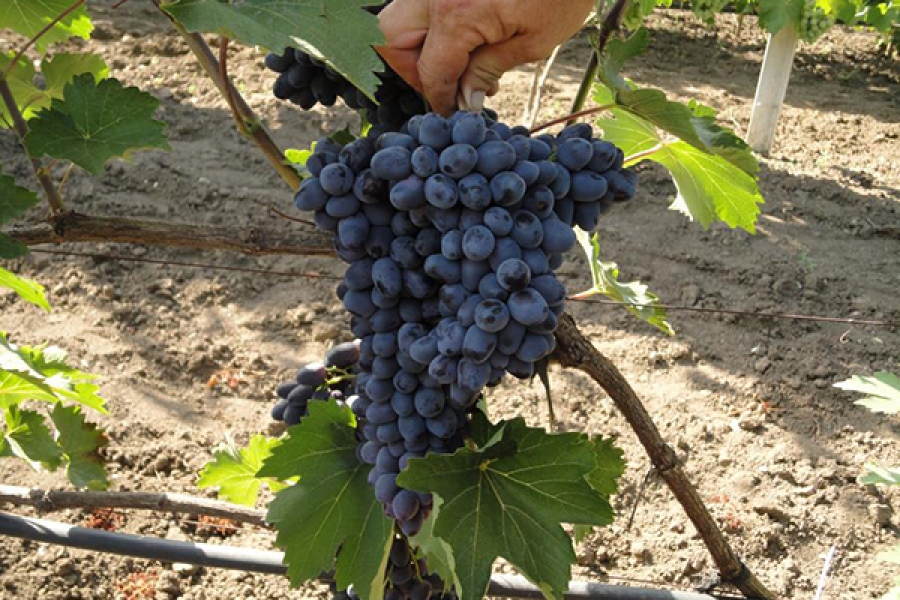
Grapes, previously considered the culture of the southern regions, began to be successfully grown in colder climates. One of the varieties suitable for the middle strip is Charlie grapes (Anthracite). This is a hybrid that is resistant to fungal infections, weather fluctuations and, importantly, is simple in agricultural technology. The variety is popular among lovers of the vine not only for these properties, but also for its taste.
Content
Grade Features
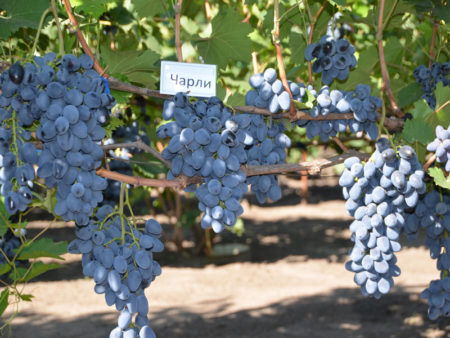
The hybrid was bred on the basis of long-known domestic varieties Nadezhda AZOS and Victoria. The first tests of seedlings took place in the southern regions of Belarus, then the variety worked well in the Black Sea regions and some parts of central Russia. It was listed in the State Register of the Russian Federation in 2015 as an Anthracite variety. Now this hybrid form has two names, but the name Charlie is better known.
Bush characteristic
A distinctive feature of Charlie is the ability of the vines to fully ripen by the beginning of autumn, and for areas where the summer is short, this fact is important - a matured vine will tolerate wintering well.
On one vine, up to 7 ovaries can form, but this amount may not completely mature, therefore it is recommended to leave no more than 2 brushes. The vine is strong, can withstand even more, but ripening will greatly stretch in time, and in case of cool weather the berry will not have time to fully ripen.
The leaf plate is light green in color and slightly pubescent. Pollination does not require the presence of other plants on the site — the flowers form bisexual.
The variety belongs to mid-season varieties - the growing season lasts 105-115 days. The fruits gain the maximum amount of sugar (18-22%) over a long time - the saturated color of the berries does not yet indicate their full ripeness.
Already in the second year, up to several brushes weighing about 1 kg can mature on the bush, and the yield of an adult bush is 15-20 kg.
In cold winters, the vine withstands frosts of -24 ° - -25 ° C and is able to recover from frost in the spring or after exposure to adverse factors, such as hail, heavy rain. In regions with severe frosts, it is advisable to shelter plantings for the winter - this will guarantee their safety at too low temperatures.
Like other varieties, Charlie is susceptible to fungal and other infections, but it is characteristic that timely prevention can completely eliminate infection.
Fruit characterization
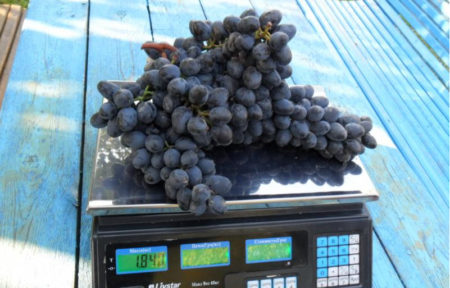
Each grape variety has the distinctive characteristics of berries, which are fundamental when choosing material for planting and growing. Charlie fruits are characterized by the following features:
- the brush has an irregular shape, most often irregularly conical;
- ovoid berries (5–9 g) in the bunch are loosely arranged - average friability;
- bunch length 35-40cm, weight - 700-900g;
- the color of the dense skin is dark blue;
- dense pulp with 2-3 seeds is very juicy;
- taste characteristics are rated at 8.4 points out of 10 possible; acidity is 7-4g / l;
- when transported over a long distance, the fruits are well preserved;
- tastes are not lost during long-term storage;
- use - a table type suitable for making wines, canning.
Advantages and disadvantages
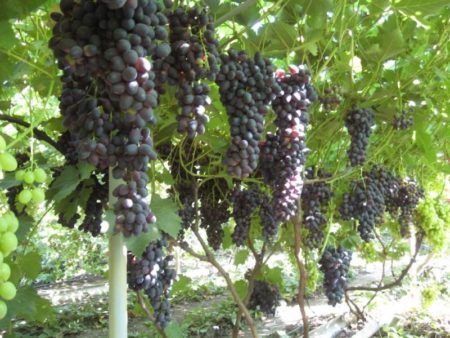
Among varieties with medium ripening dates, Charlie has a number of advantages that distinguish it noticeably:
- stable rate of productivity;
- clusters ripen evenly;
- excellent transportability;
- marketable condition;
- cultivation on small and large areas is possible;
- good immunity to diseases and pests;
- berries are almost the same size, there is no peas;
- high resistance to frost, spring temperature drops and high humidity;
- various applications (storage, conservation, preparation of juice and wine).
Experts do not find significant shortcomings, except for the presence of a nightshade taste in unripe fruits.
Site and soil requirements
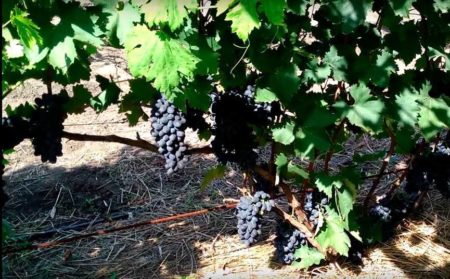
A correctly selected site is the key to good bush growth and, as a result, high productivity.
For the formation of ovaries and ripening of berries, an important role is played by illumination, therefore, the site should be in a sunny place and not be in a draft. The best option is a place near the fence or building, directed to the south. In areas with a slope, you should choose the south or southwest slope with a south-north direction.
If it is not possible to plant grapes near the building, you can specially build a fence (east-west direction), 1.8-2 m high - it will create conditions for good lighting and protect it from winds.
The following fact should also be taken into account - after previous planting of grapes in this place, you can plant a vine only after 3 years.
The variety has no particular preferences for soil, but it is important that there is no stagnation of water on the site - the groundwater level is not higher than 1.5 m. With a higher location, the roots lack oxygen.
It is undesirable to plant crops that require more moisture than grapes nearby.
Selection and procurement of planting material
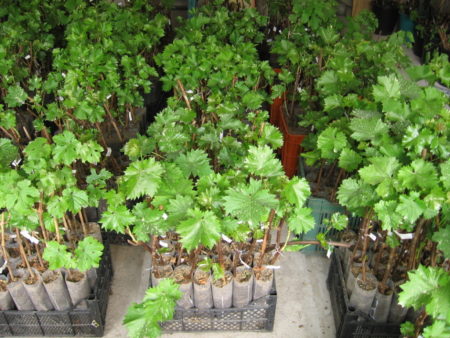
A good strong seedling creates the prerequisites for the growth of a strong and powerful vine. It is better to purchase it with a closed root system (in a container) in garden farms or nurseries, where there is information about the variety and growing conditions.
When examining a bush of a seedling, you need to pay attention to the height of the shoots (50-60cm) and the presence of 2-3 elastic roots.
Harvesting of planting material at home
The procurement of planting material consists of several stages.
Stage 1:
- in the autumn on a strong and developed vine, 8-10 mm thick and with internodes 10 cm, remove leaves and stepsons;
- cut from it cuttings with a length of 50-60 cm with 3-4 eyes;
- moisten the cuttings in a pink solution of manganese, dry and place in water for 24 hours;
- wrap the cuttings in a film and put in a cold place with t = 0 ° - + 2 ° C.
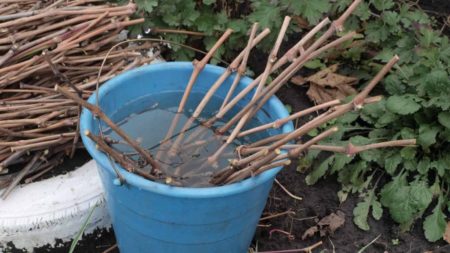
2 stage (end of February-beginning of March):
- dip the cuttings in water for 48 hours;
- make incisions with a sharp tool above the upper eye by 2 cm and under the lower eye at a distance of 3-5 mm - this technique promotes rapid germination;
- then cut the lower kidney, and lower the upper one into molten paraffin (60 ° -70 ° C) and immediately into cold water (the reception protects bacteria);
- on the bark, without hitting the wood, make 4 cuts 3 cm long.
3 stage (Sowing before rooting delays the opening of the eyes):
- in the lower part of the stalk tie with a damp cloth and twist into a film;
- place the seedling on the windowsill with the upper part to the glass, and the lower one above the battery;
- the roots will appear after 2 weeks.
How to plant seedlings
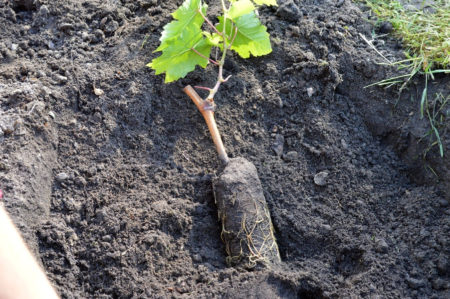
Pits should be dug out every 2 m in advance, observing the 2.5 -3 m spacing.
Pour a layer (10-15 cm) of drainage into a wide and deep hole (70x80 cm), a nutrient mixture (ash and double superphosphate 1 kg each + 16-20 kg humus and soil) onto it. Sprinkle the mixture with earth (3-4 buckets) and pour.
After absorbing water, build a small mound of soil, put a seedling on it (the tip of the cut is 50 cm below the soil level), cover it with earth and lightly compact it.
Landing care
Watering begins in April, from about the middle of the month, and continues until November. You can water under the root and in shallow (20 cm) grooves around the stem. The rate of watering per bush during the entire growing season is 10-15 liters.
Fertilizer application
Rapid vine growth and a large number of ovaries require regular top dressing:
- The beginning of April and the period of ovary formation - cow dung (10 kg) + bird droppings (5 kg) + water (40 l), insist a week and add another 10 l of water. Norm - 10 liters per bush.
- After flowering - ammonium nitrate (10 g per 1 m²).
- The beginning of fruit ripening is superphosphate (30 g) + nitrophoska (20 g) + ash (50 g) + water (10 l). Norm - 5 liters per bush.
- After harvesting - sprinkle dry cow manure (5-7 kg) near the bush.
Garter
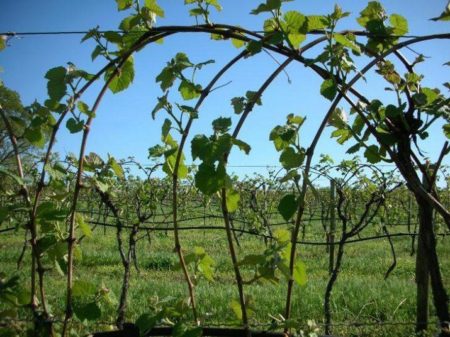
In the 2nd year of growth, to support the vine before sap flow, tie it to the trellis, forming the correct shape as it grows, which provides the necessary illumination of the hands. Secure the shoots obliquely (45 °).
Pruning
The pruning procedure significantly increases productivity due to the formation of larger brushes, and it is carried out 3 times per year:
- after winter, when the temperature is set at not lower than 5 ° C and the sap flow does not start, cut off dry and frozen shoots;
- in summer, remove stepchildren for better air circulation;
- in mid-autumn, shorten shoots to 6–9 eyes before frosts — 30–35 buds should remain on the bush.
Shelter for the winter

It is recommended to cover the vine for the winter when low daytime and night temperatures are established, otherwise the shoots under the shelter may mate. The vine removed from the support should be laid out on the ground and covered with a spruce top. Such a shelter before the establishment of snow cover is enough. Then, when the snow falls, regularly pour it on the branches. Around it is necessary to spread the poison for rodents.
Reviews
Sergey Ivanovich, Izhevsk
- The plot in my country house is small, and I decided to allocate a place for grapes near the arbor. It turned out very practical - beautiful and does not take up much space. Charlie has been growing for 4 years. By the autumn, all the clusters, and I leave them 3-4, mature. After harvesting, I store the berry in a cool room until it starts to deteriorate. Until this moment, we use it for juice, we just eat it, and from the leftovers I make homemade wine. The taste, at first specific, then disappears, but I came from the village and loved nightshade in childhood, so I like this taste.
Zoya Petrovna, Omsk
“Charlie is grown exclusively for wine.” The harvest is always good, but fresh berries do not like me completely. But a mixture of several varieties, along with Charlie gives a good wine material, and the wine is wonderful. I carry out normalization, as in our climate a large number of brushes simply will not mature, and why overload the bush.




 Non-covering winter-hardy grape varieties for Moscow region
Non-covering winter-hardy grape varieties for Moscow region How to keep the vine in winter
How to keep the vine in winter When can I transfer grapes to another place in the fall
When can I transfer grapes to another place in the fall How to cover and prepare grapes for the winter in the suburbs
How to cover and prepare grapes for the winter in the suburbs